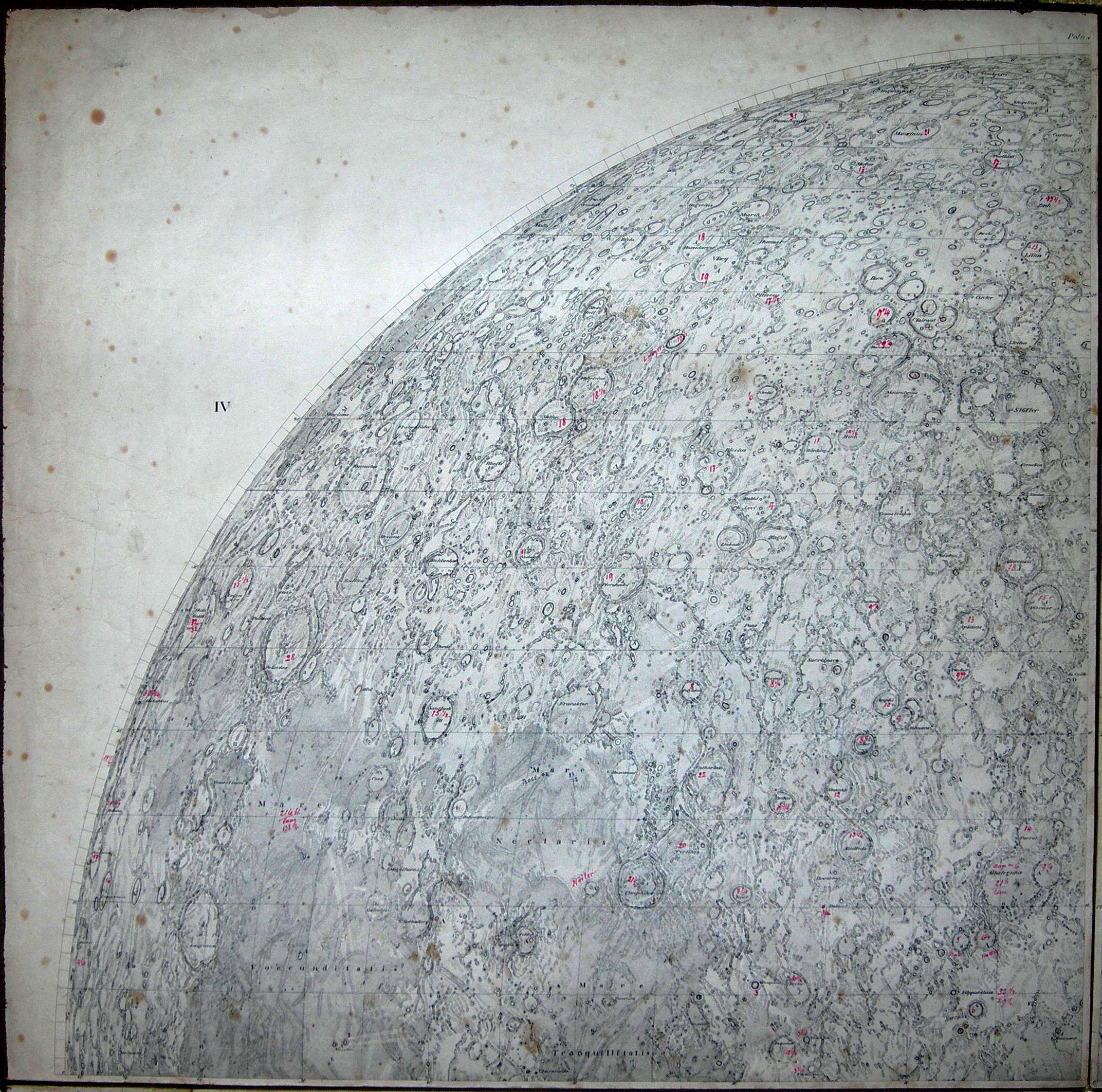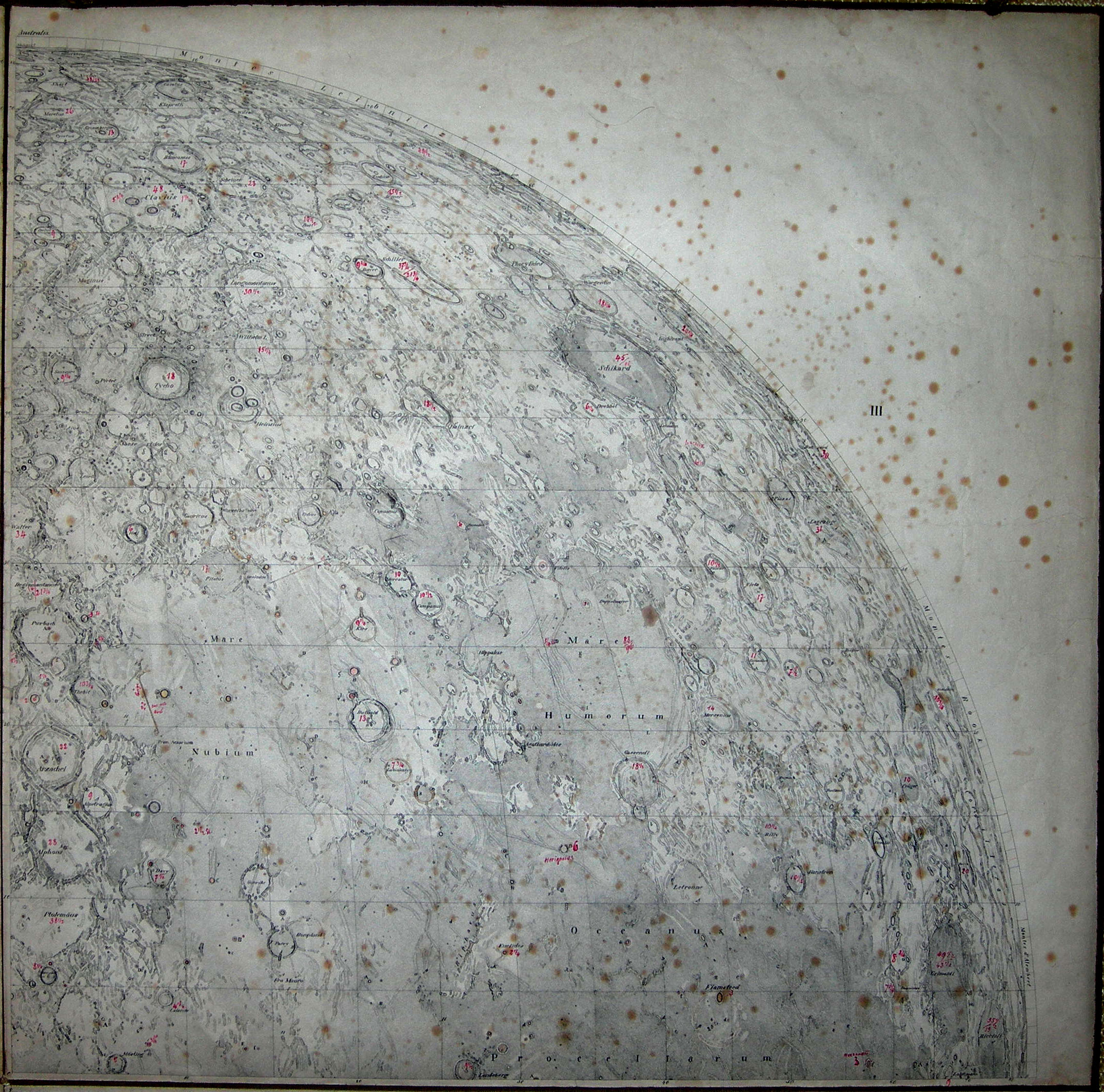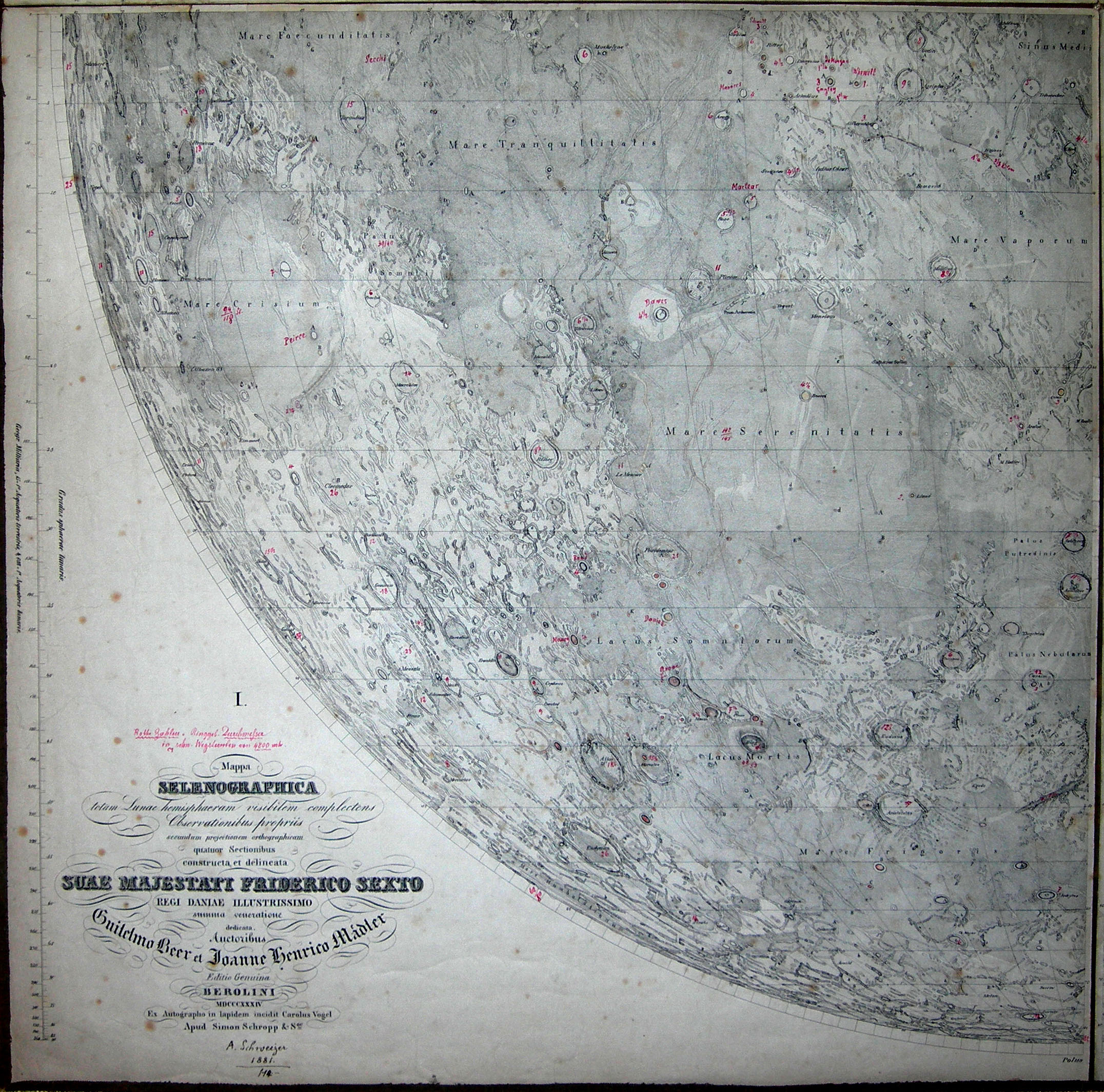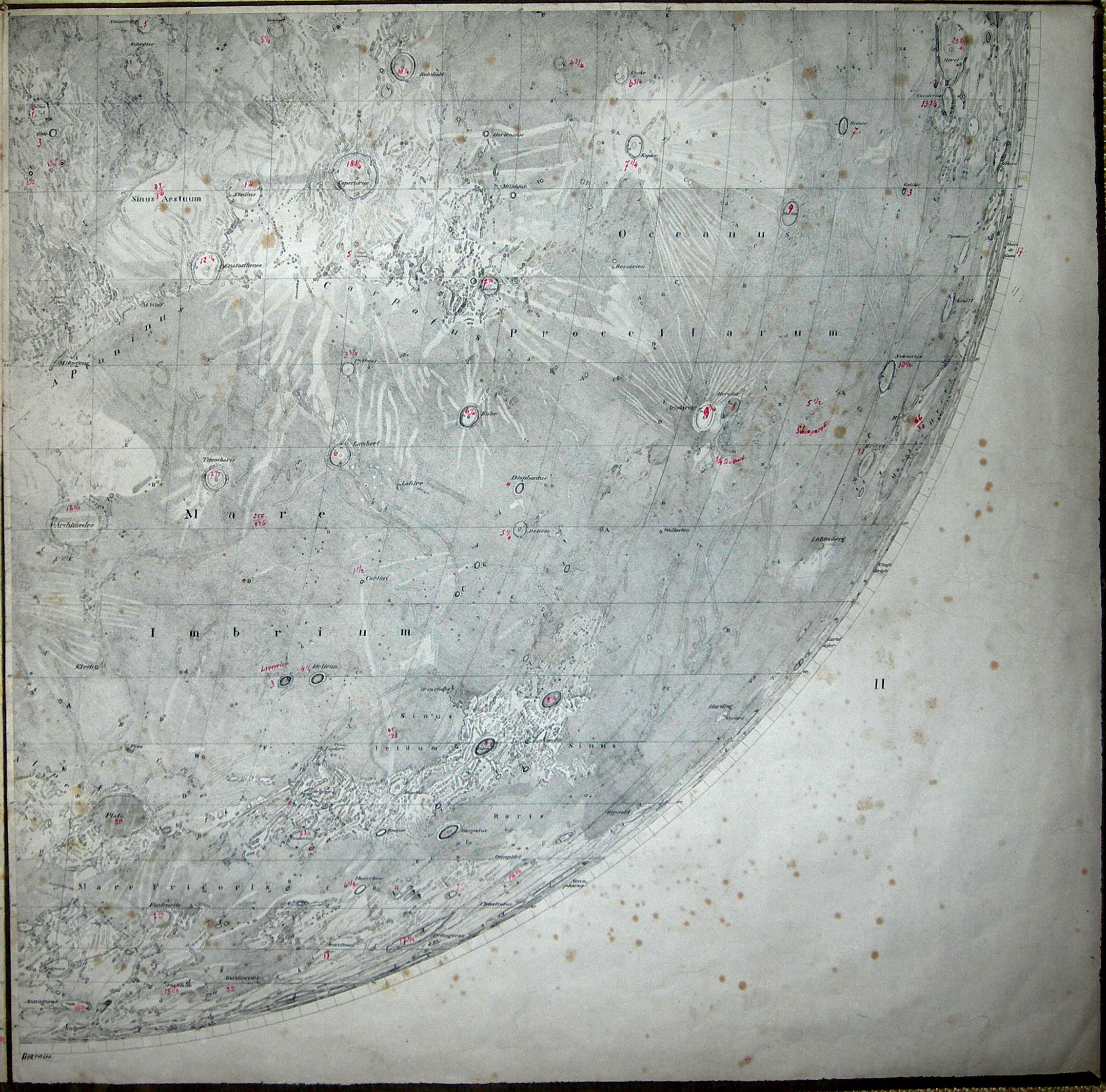Beer and Mädler
Contents
Beer and Mädler: Mappa Selenographica and Der Mond (1834-1837)
(glossary entry)
Description
Beer and Mädler's map series, Mappa Selenographica (1834-1836), and subsequent large book Der Mond (1837) represent one of the major efforts of the 19th century to develop a system of systematic lunar feature names and positions. The craters Beer and Mädler are named after the authors.
Additional Information
- At least two digital scans of the German text of Der Mond are available on Google books:
- A copy from Oxford University.
- A copy from the University of Michigan.
- According to Wilkins and Moore Beer and Mädler, equipped with a 3-3/4 in (95 mm) refractor, studied the Moon together (Mädler doing most of the observing) from 1824 to 1840, when Mädler left Berlin to become director of the Dorpat Observatory in Estonia. - JimMosher
- Beer and Mädler established the modern system of designating secondary craters by assigning to them a letter associated with a nearby "parent" crater, and of labeling them on the map by placing the letter on the side facing the parent. They also assigned Greek letters to elevations, ridges and rilles. Most later cartographers adopted this notation, although rilles were more often designated with Roman numerals. Upper case letters (both Roman and Greek) were used to name features whose positions had been measured at the telescope, and lower case letters for those whose positions were estimated from the measured ones. Before Beer and Mädler, Johann Schröter had used Roman and Greek letters to designate secondary features, but not in any systematic way.
- The map, at a scale of 38 inches to the lunar diameter, was published in four quadrants, appearing between 1834 and 1836. Beer and Mädler's system of numbering the quadrants was followed by many subsequent mappers and describers of the Moon.
Here are the four Mappa Selenographica quadrants photographed in their original south-up orientation by Jörn Koblitz from a copy in his personal collection, with red annotations added by a previous owner (click quadrants to see full sized):
| IV |
III |
| I |
II |
The map appears to be affixed to folding cardboard covers, opening so the entire map can be viewed at one time. It is dedicated, in the lower left of Quadrant I, in Latin, to Frederick VI of Denmark.
- A different, and presumably later, version of the map (with the dedication in the upper left and lunar details in the corners) is displayed on the web store of Peter Grego. High resolution scans of an unknown version can also be purchased on DVD-ROM from Atlas Lunarum
Although published with south at top, in the modern system of IAU directions the four Roman numeraled quadrants divide the visible disk of Moon at zero libration as follows:
| N | |||
| W |
II |
I |
E |
| III |
IV | ||
| S | |||
Note that what is here designated "W" was called "east" and what is here designated "E" was called "west" in Beer and Mädler as in all maps and descriptions published prior to 1961.
- Beer and Mädler's extensive set of measured positions (used to correct the maps to zero libration, and published in the accompanying book) served as the basis for several later maps, such as those of Neison, 1876 and Schmidt, 1878.
- Beer and Mädler adopted the nomenclature of Riccioli, supplementing it with the names of mountain ranges used by Hevelius, and names added by Schröter and Lohrmann, as well as many more of their own invention.
- The tables starting on page 29 attempt to identify the names used for the identical features in the various systems, including on page 36 the now-lost historic names for bright landmasses. Beer and Mädler discarded the latter on the grounds that these names of Hevelius and Riccioli had been in long disuse and it was difficult to determine which landmasses they had designated (even though the meanings of many of them are quite clear). - JimMosher
- Beer and Mädler's catalog of primary crater names (followed by short tables of non-crater names) appears starting on page 37. The crater names followed by an H, R, S or L were introduced by Hevelius, Riccioli, Schröter and Lohrmann. The remainder are the new inventions.
- Beer and Mädler's names were adopted by Webb in the first edition of his Celestial Objects for Common Telescopes (1859). Webb lettered the 22 seas and numbered 404 other objects (in the tables starting on page 100), for a total of 426 names.
LPOD Articles
The End of Lunar Studies
No Beer Here
B&M
Bibliography
- Beer, Wilhelm, and Johann Heinrich Mädler. 1834. Mappa selenographica totam lunae hemisphaeram visibilem complectens observationibus propriis secundum projectionem orthographicam quatuor sectionibus constructa et delineata. Belin: S. Schropp et Comp.
- Beer, Wilhelm, and Johann Heinrich Mädler. 1837. Der mond nach seinen kosmischen und individuellen verhältnissen; oder, Allgemeine vergleichende selenographie mit besonderer beziehung auf die von den verfassern herausgegebene Mappa selenographica. Berlin: S. Schropp & comp.
- Sample map from Linda Hall Library exhibit.
- Southeast quadrant of Beer & Madler Moon map, 1834 (print for sale from Science Museum)
- Auctioned set
- Wikipedia biography of Beer
- Wikipedia biography of Mädler
A slightly later joint publication by Beer and Mädler, regarding observations of solar system bodies, includes additional drawings of the Moon's north polar regions:
- Beer, Wilhelm and Johann Heinrich Mädler. 1841. Beiträge zur physischen Kenntniss der himmlischen Körper im Sonnensysteme. Weimar: Verlag von Bernhard Friedrich Voight.



